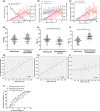The role of peripheral blood eosinophil counts in COVID-19 patients
- PMID: 32562554
- PMCID: PMC7323233
- DOI: 10.1111/all.14465
The role of peripheral blood eosinophil counts in COVID-19 patients
Abstract
Background: Coronavirus disease 2019 (COVID-19) emerged in Wuhan city and rapidly spread globally outside China. We aimed to investigate the role of peripheral blood eosinophil (EOS) as a marker in the course of the virus infection to improve the efficiency of diagnosis and evaluation of COVID-19 patients.
Methods: 227 pneumonia patients who visited the fever clinics in Shanghai General Hospital and 97 hospitalized COVID-19 patients admitted to Shanghai Public Health Clinical Center were involved in a retrospective research study. Clinical, laboratory, and radiologic data were collected. The trend of EOS level in COVID-19 patients and comparison among patients with different severity were summarized.
Results: The majority of COVID-19 patients (71.7%) had a decrease in circulating EOS counts, which was significantly more frequent than other types of pneumonia patients. EOS counts had good value for COVID-19 prediction, even higher when combined with neutrophil-to-lymphocyte ratio. Patients with low EOS counts at admission were more likely to have fever, fatigue, and shortness of breath, with more lesions in chest CT and radiographic aggravation, and longer length of hospital stay and course of disease than those with normal EOS counts. Circulating EOS level gradually increased over the time, and was synchronous with the improvement in chest CT (12 days vs 13 days, P = .07), later than that of body temperature (12 days vs 10 days, P = .014), but earlier than that of the negative conversion of nucleic acid assays (12 days vs 17 days, P = .001).
Conclusion: Peripheral blood EOS counts may be an effective and efficient indicator in diagnosis, Evaluation, and prognosis monitoring of COVID-19 patients.
Keywords: COVID-19; diagnosis; peripheral blood eosinophils; pneumonia; prognosis.
© 2020 EAACI and John Wiley and Sons A/S. Published by John Wiley and Sons Ltd.
Conflict of interest statement
None of the authors have any conflict of interest to declare.
Figures



References
-
- WHO . Novelcoronavirus –China. http://www.who.int/csr/don/12‐january‐2020‐novel‐coronavirus‐china/en/. Accessed Jan 19, 2020.
Publication types
MeSH terms
Substances
Grants and funding
- YG2020YQ22/Shanghai Jiaotong University medical and engineering scientific fund for COVID-19
- 2020XGZX009/Zhejiang University special scientific research fund for COVID-19 prevention and control
- 2020YJKY01/Shanghai Public Health Clinical Center special projects in scientific research for COVID-19 prevention
- NO IDF162005/The first class discipline construction project of Fudan University
LinkOut - more resources
Full Text Sources
Medical

